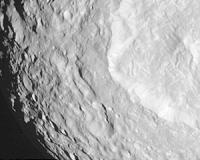 |
Pasadena CA (JPL) Feb 22, 2010 Like the battered white whale Moby Dick taunting Captain Ahab, Saturn's moon Prometheus surges toward the viewer in a 3-D image from NASA's Cassini spacecraft. The image exposes the irregular shape and circular surface scars on Prometheus, pointing to a violent history. These craters are probably the remnants from impacts long ago. Prometheus is one of Saturn's innermost moons. It orbits the gas-giant at a distance of about 140,000 kilometers (86,000 miles) and is 86 kilometers (53 miles) across at its widest point. The porous, icy world was originally discovered in images taken by NASA's Voyager 1 spacecraft back in 1980. Cassini's narrow-angle camera captured two black-and-white images of the moon on Dec. 26, 2009, and the imaging team combined the images to make this new stereo view. It looks different from the "egg-cellent" raw image of Prometheus obtained on Jan. 27 because that view shows one of the short ends of the oddly shaped moon. In this 3-D image, the sun illuminates Prometheus at a different angle, making the moon's elongated body visible.
Share This Article With Planet Earth
Related Links Cassini Equinox Mission Explore The Ring World of Saturn and her moons Jupiter and its Moons The million outer planets of a star called Sol News Flash at Mercury
 Cassini Shoots New Close-Ups Of Death Star-Like Moon
Cassini Shoots New Close-Ups Of Death Star-Like MoonPasadena CA (JPL) Feb 18, 2010 Blazing through its closest pass of the Saturnian moon Mimas on Feb. 13, Cassini sent back striking close-ups of the moon likened to the Death Star from "Star Wars" and the enormous crater scarring its surface. The flyby also yielded solid data on the moon's thermal signature and surface composition. Some of the raw, unprocessed images sent back from the flyby show the bright, steep slopes ... read more |
|
| The content herein, unless otherwise known to be public domain, are Copyright 1995-2010 - SpaceDaily. AFP and UPI Wire Stories are copyright Agence France-Presse and United Press International. ESA Portal Reports are copyright European Space Agency. All NASA sourced material is public domain. Additional copyrights may apply in whole or part to other bona fide parties. Advertising does not imply endorsement,agreement or approval of any opinions, statements or information provided by SpaceDaily on any Web page published or hosted by SpaceDaily. Privacy Statement |